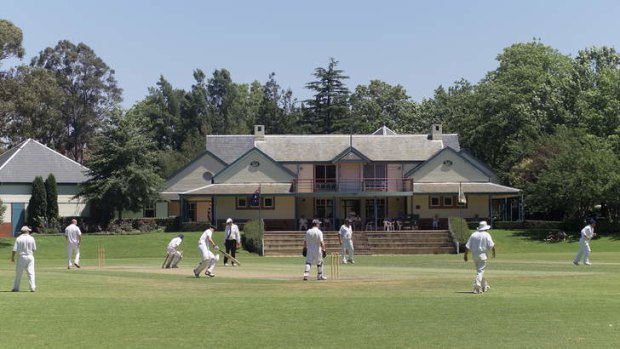
Bradman Oval, Bowral.Credit: Getty Images
Daniel Scott follows in the footsteps of an Australian sporting giant — but his score is a little different.
As I walk to the crease I can see my future clearly. I will play for my country and become the greatest cricketer that lived. I'll score centuries for fun, be the only Test player to hit 300 runs in a single day, and earn the accolade "the greatest living Australian" from former prime minister and cricket tragic John Howard.
Today, my second game for Bowral school at an oval that will later be named after me, I am fully focused on making my first century.

The statue of Sir Don Bradman by the artist Tanya Bartlett standing in front of the Bradman museum in Bowral.Credit: Getty Images
I watch the bowler's run-up intently, see him release the ball and meet it as it pitches, smiting it for four. Nerves eased, I look around the small, green Southern Highlands' oval, assessing gaps in the field.
My second ball arrives and I stride forward, smacking it to the bowler's left. Alas I am not Sir Donald Bradman, nor was I meant to be.
Diving, the impertinent bowler from Queensland takes an heroic catch, sending me back to the pavilion 111 runs short of Bradman's score that second game.
For all of us who will never be as good as "the Don", there is always our imagination. In my case there is also the chance to bat on the same wicket as my hero in an annual cricket match played at Bowral's Bradman Oval. No matter what your age, as a bloke you are forever 12, like Bradman in that game, and far more talented a sportsman than reality suggests.
Bowral, and its wonderful International Cricket Hall of Fame at the oval, encourages anybody who has played the game to dream. The town is so steeped in Bradman's youth, and the man himself so central to the sport's history, that it ranks alongside Lord's in London as cricket's spiritual home.
Born in Cootamundra in south-western NSW in 1908, Don Bradman moved to Bowral when he was three. In his early years he lived at 52 Shepherd Street, a pretty one-level home at the edge of town.
But it was in 1924, when he moved close to the oval at 20 Glebe Street, a red-brick bungalow fronted by a picket fence, that the teenage Bradman began realising his aspirations. Both childhood homes are on a 10-stop "Bradman Walk" that begins at the Hall of Fame and takes in places associated with the "boy from Bowral". Other points of interest include St Jude's Church, where he was a choirboy; Bowral Public School, where the headmaster labelled him "an unusually bright lad"; and the real-estate agency where he worked before moving to Sydney.
Taking the walk, you can't help but subscribe to the squeaky-clean image of the great man. It's an impression reinforced by a quote adorning a life-size statue of him outside the Hall of Fame: "Future generations will remember him ..." cricket commentator Arthur Gilligan wrote, "above all, as one of the truest gentlemen who has ever worn flannel."
But there was another side: ferociously ambitious, Bradman didn't form close relationships, even with other players, nor enjoy adulation. In shying away from it, he came across as aloof. Nonetheless, with his spectacular exploits against old adversary England, particularly during 1930s tours when he twice scored triple centuries, he became Australia's reluctant idol.
In his retirement, Bradman himself oversaw the development of Bowral's cricket museum, which evolved to become the International Cricket Hall of Fame. A mine of cricketing information, it uses interactive technology to bring the game vividly to life.
Apart from the Bradman gallery, which details his life and displays his first bat and baggy green cap, the museum has a wealth of exhibits. These include panels detailing its origins, explanations of batting and bowling techniques, and a "Greats of the Game" gallery.
There is also extensive video coverage to see, including a short film of Kerry Packer's World Series, which, in 1977, changed the face of the game.
From the 14th century when "cricce", meaning "crooked staff" in Anglo-Saxon, was played among shepherds in England's south, to the 21st century when luridly-clad multimillionaires entertain huge global television audiences, the Hall of Fame has it covered. One of the most interesting stories concerns the first tour of England by an Australian team, made up entirely of Aborigines, in 1868.
Even if cricket bores you rigid, the human stories behind it make visiting the Hall of Fame and the Bradman Oval compelling. That was the hope of Bradman himself.
"In the twilight of a long and happy life, I still think cricket is the finest character builder of all our sports," he said at the museum's inauguration in 1996, "and in the years ahead I trust that the museum in its lovely setting will be the catalyst to encourage and inspire the young people of Australia to serve their nation with courage, honour and humility."
Following his death in 2001, Don Bradman's ashes were scattered around the Bowral oval.
Daniel Scott was a guest of Peppers Craigieburn and Tourism Southern Highlands and travelled courtesy of Destination NSW.
Trip notes
Getting there
Bowral is two hours' drive south of Sydney via the M5 or M7 and is served by regular trains, journey time 2½ hours. cityrail.info.
Staying there
Peppers Craigieburn, a heritage property on the edge of Bowral, has a "Bradman Experience" package from $219 a night, valid to June 30. It includes accommodation, breakfast and two tickets to the Lights Packer Action exhibition at the International Cricket Hall of Fame. (02) 4862 8000, peppers.com.au/craigieburn.
International Cricket Hall of Fame, St Jude Street, Bowral, opens daily, 10am-5pm. Entry $20 adults, $10 children. internationalcrickethall.com.
More Information
Sign up for the Traveller Deals newsletter
Get exclusive travel deals delivered straight to your inbox. Sign up now.